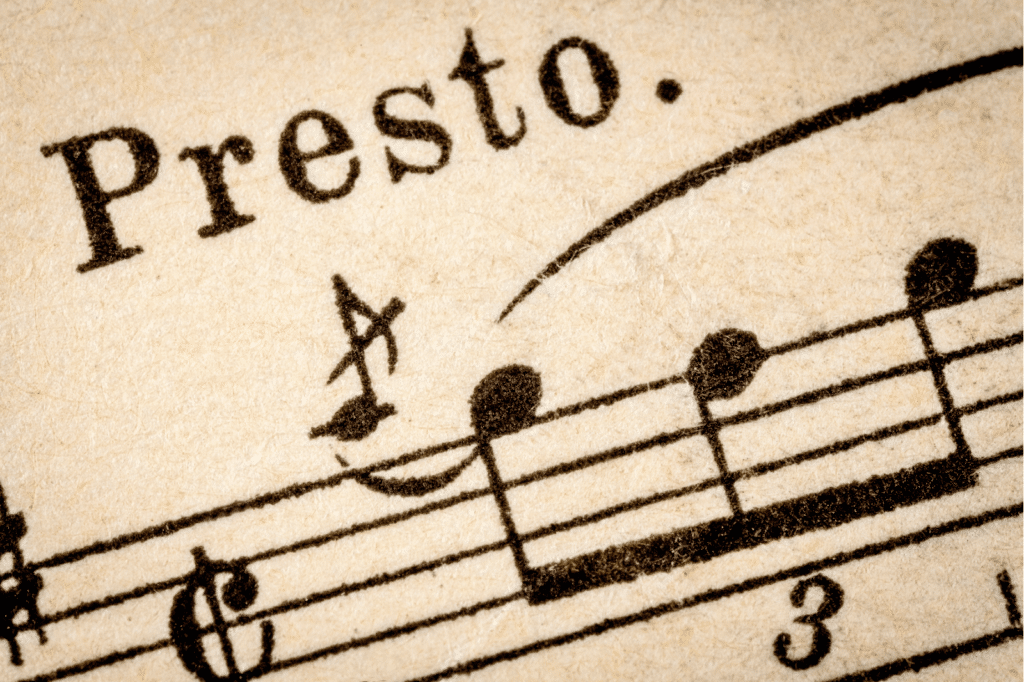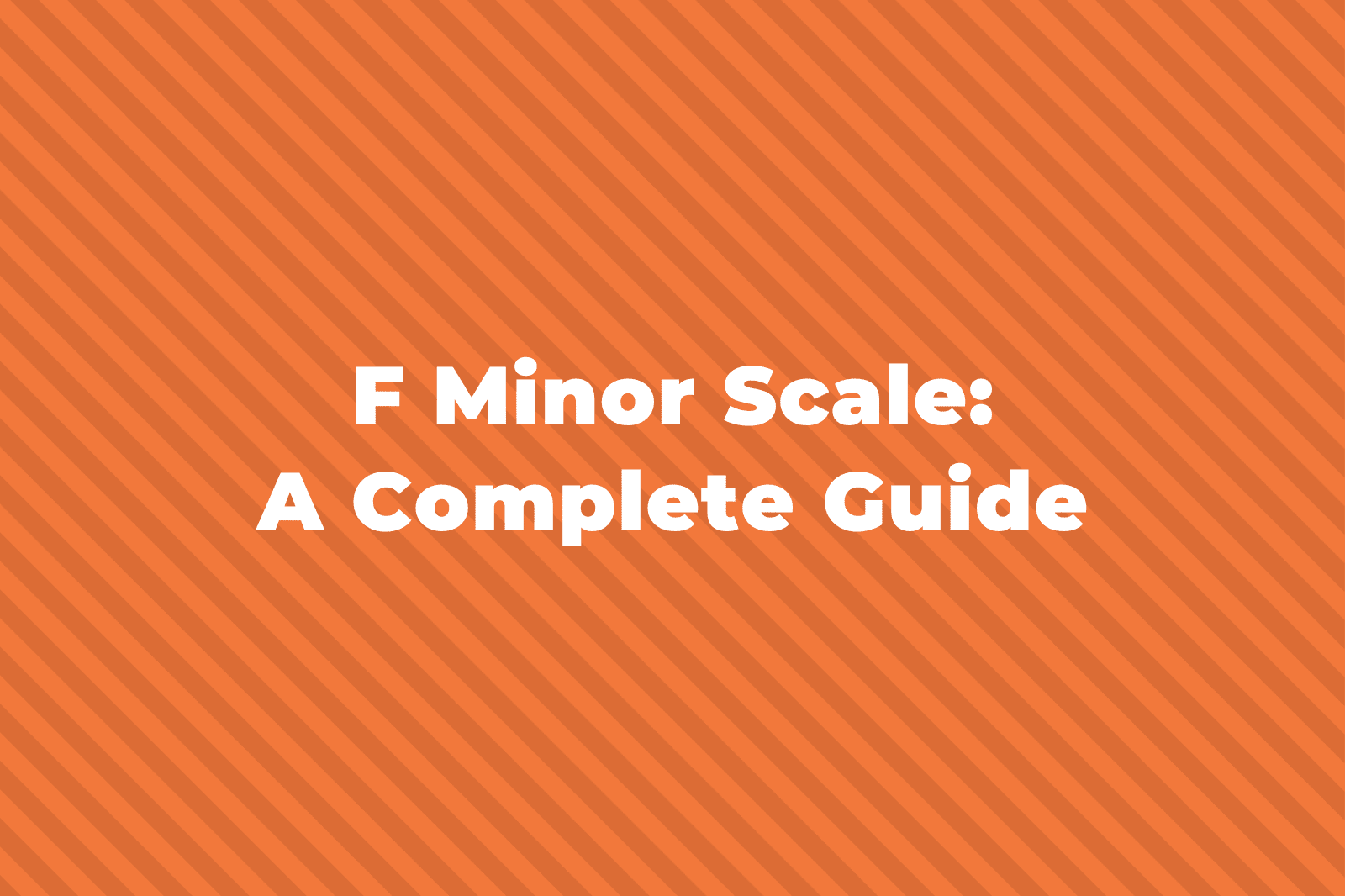Presto is an Italian term that translates to “very fast” or “quickly.” It’s used in music to indicate to the musician to play rapidly and with agility.
When you come across a musical piece marked as presto, it’s your cue to play with pace and not hang about!
Other words used to describe it are “swift,” “rapid,” “energetic,” or “lively.”
How Fast Is Presto?

It’s one thing to say that presto means “very fast,” but what does that mean in terms of actual tempo? How exactly fast are we talking?
To avoid the guesswork, we can turn to a reliable friend — the metronome. The tempo for presto typically ranges between 168 and 200 BPM (beats per minute).
This range is crucial. While it clearly suggests a brisk pace, there’s still room for a touch of personal interpretation that the composer leaves up to the performer.
Recommended Reading
Want to go a bit deeper? Click here to learn more about how we describe tempo in music.
Historical Context And Etymology Of Presto
Presto, in Italian, literally means “quick” or “immediate.” But it also comes from the Latin word praestus, which means “at hand” or “ready.”
This root of the word helps us to understand that playing at a presto tempo isn’t just about pace; it’s about capturing a sense of urgency and readiness.
Historically, the first use of presto as a musical term is thought to have come about in the Baroque era by composer Purcell in the 1680s. Composers of the Baroque period, like Vivaldi and Bach, often used presto to conclude their fast-paced, dynamic compositions.
The Baroque era’s fondness for contrast and dramatic expression made presto an ideal choice for showcasing a composer’s technical prowess and the emotional intensity of the music.
It was during this period that presto firmly established its place in the lexicon of musical tempos, becoming synonymous with speed, agility, and the thrilling culmination of musical works.
Related Terms To Presto
- Prestissimo: Even faster than presto, this term is used for the most rapid and brisk tempos possible in music. It’s like pushing the boundaries of speed to the extreme (200+ BPM).
- Presto agitato: This combines presto with a sense of agitation or restlessness, suggesting a fast tempo with an added layer of emotional intensity or urgency.
- Presto con fuoco: Translating to “fast with fire,” it implies a performance that is not only rapid but also passionate and fiery.
- Presto ma non troppo: Meaning “very fast, but not overly so,” it indicates a tempo that is quick yet controlled, without going to the extremes of Prestissimo.
- Presto vivace: A blend of presto and Vivace, indicating a tempo that is both fast and lively, imbuing the piece with a vibrant and spirited character.
- Presto leggero: This suggests a light, nimble approach to the fast tempo, emphasizing agility and delicacy even within the rapid pace.
- Presto con brio: Meaning “fast with vigor,” it suggests a performance that combines rapid tempo with energetic, spirited playing.
- Presto scherzando: Scherzando means “playful” or “joking,” so this term indicates a fast tempo with a playful, light-hearted character, adding a sense of whimsy to the rapid pace.
Examples Of Presto Tempo Music
Finally, here are some examples of presto in music to give you an idea of how fast it should be played.
“The Four Seasons: Summer (3rd Movement)” By Antonio Vivaldi
In contrast to his bright and buoyant “Spring,” Vivaldi’s “Summer” from The Four Seasons features a stormy and intense third movement marked presto.
It captures the sudden, tempestuous summer storms, showcasing Vivaldi’s masterful ability to paint vivid pictures with music.
“Symphony No. 4 In A Major, Op. 90 ‘Italian’ (4th Movement)” By Felix Mendelssohn
Mendelssohn’s Symphony No. 4, known as the “Italian,” concludes with a vibrant and exuberant fourth movement marked presto.
This movement is often celebrated for its lively rhythms and joyous spirit, embodying the composer’s impressions of Italy’s color and warmth.
The presto tempo here adds a sense of exhilarating vitality, making it a fitting and memorable finale to this beloved symphony.
“String Quartet No. 14 (4th Movement)” By Franz Schubert
Schubert’s “Death and the Maiden” quartet concludes with a presto movement that is both vigorous and compelling.
This movement’s rapid tempo and relentless energy serve as a fitting climax to one of Schubert’s most celebrated works.
“Piano Sonata No. 2 (4th Movement)” By Frédéric Chopin
The 3rd movement of Frédéric Chopin’s Piano Sonata No. 2, which is often referred to as the “Funeral March,” is followed by a swift and technically challenging 4th movement, which is presto.
Chopin’s use of Presto here creates a stark contrast with the preceding movements, adding a sense of ethereal lightness and rapidity.



